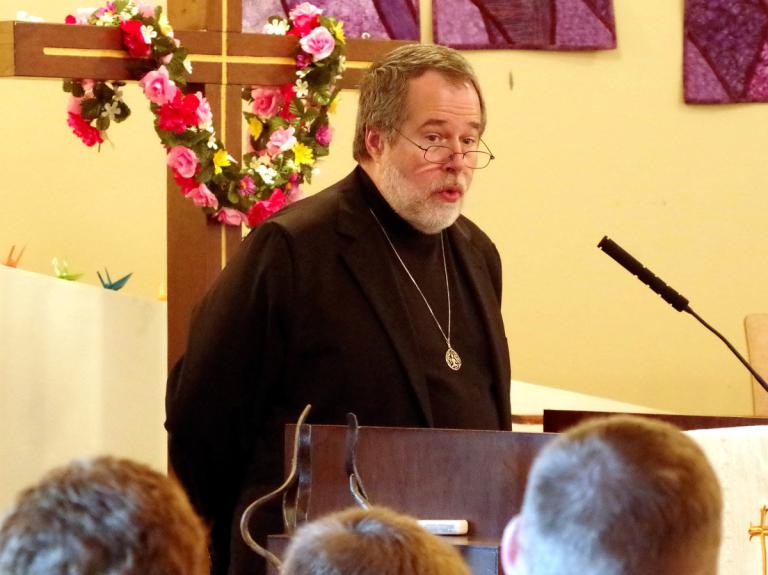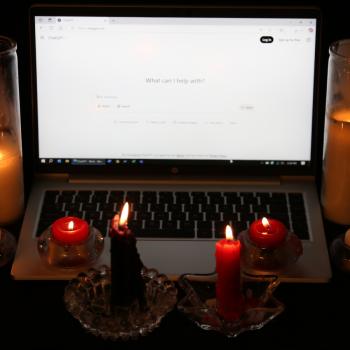Here’s the rest of this cycle of Conversations Under the Oaks: Pagan leadership roles, the limits of interfaith activities, Pagan monotheists, and how to have our own temples.
Questions have been edited for length and clarity.
What are the often overlooked roles for leaders in religious communities? Pagan specifically, but I suspect there’s a lot of generalizability to these sorts of roles.
Much of my early blogging is cringe-worthy – I was still fulfilling Ray Bradbury’s observation that everyone’s first million words are crap. But this piece from 2010 titled Pagan Leadership – Roles has held up rather well. Of what’s in that post, I think the most frequently overlooked role is that of bard. We appreciate our musicians and storytellers but we don’t see what they do as leadership. This is a mistake.
A good bard can find just the right story or song for just the right situation, and in doing so, motivate people not just to do something, but to do the right something.
And you’re correct about the overlap of applications – this isn’t just a Pagan thing, or even a religious thing. Some of the best business leaders I’ve worked with have been big on telling stories. Not clichéd “motivational” stories, but real stories from real life that remind people of what’s important and what can be done.
Is there value in interfaith activities? Would it be ethical for a Pagan to attend a devotional study circle or prayer session with friends of a monotheistic religion?
Interfaith activities and groups can be of great value in building community relations and in combining resources to make the world a better place. But they must be grounded in mutual respect for our differing religious beliefs and practices.
I’ve been a participant in several interfaith prayer services. Christians, Muslims, Buddhists, and others all offered prayers in their own ways for the good of the community and the nation. Those services worked well because they honored our differences. They didn’t try to erase them or whitewash them – they didn’t pretend that “deep down we’re all the same.”
But when you start participating in the rites of another religion, then you’re no longer working together as equals. Now you’re walking down the path to conversion – and if you’re dealing with most Christians, that’s absolutely their intent.
My wife sings in the choir of her Methodist church. I attend their Christmas and Easter music programs to support her. I’m a passive participant – I can appreciate the music (which is usually excellent) and I can tune out the religious messages I disagree with. But I do not participate in her Bible study programs. If I did, I would either offer a perspective that would be unhelpful to the rest of the class, or I would start to accept a perspective that would be unhelpful to me as a Pagan and a polytheist.
Further, I had to make a clean break with Christianity. If you came from an abusive or difficult religious background, you may need to do the same.
We can work together where we have common cause and mutual respect. But when it comes to worship and devotion, respect for our own religion – and theirs – requires that we stay within our own traditions.

What do you think about monotheism inside the Big Tent of Paganism? The Goddess I’ve started a relationship with is claimed to be “The One and Only” by a group that is worshipping Her.
With the possible exception of Akhenaten, monotheism was unknown in ancient times. It’s an unnatural religious outlook. Christians and Muslims have to spend considerable effort enforcing orthodoxy, otherwise their followers begin to do what humans naturally do: acknowledging and honoring many Gods.
Now, henotheism is a legitimate religious approach. It acknowledges the reality of many Gods but only worships one. Not as in “ours is the only real God” but as in “we have an exclusive relationship with our God.” Perhaps you’ve misunderstood their intent, or perhaps they haven’t articulated it well.
Or perhaps you understand them just fine and they’re not as Pagan as they think they are.
I’m not as fond of the Big Tent of Paganism metaphor as I was when I wrote it five years ago, probably because I’m much less optimistic that we can come together under the tent. When we’re able to work together, it’s usually in an interfaith setting (as described above) not as many “denominations” of one religion.
I have friends who think I should abandon the term “Pagan” and simply call myself a polytheist. I’m part of the modern Pagan tradition and so I still maintain a Pagan identity. But it’s becoming less and less useful – this is one of the reasons why.
What can Pagans and polytheists do to have their own temples? It’s a goal that’s been talked about since the 90s if not earlier.
Build local groups that are big enough, stable enough, and dedicated enough to support building and maintaining temples. It’s really that simple.
From my experience with UU churches, you need about 50 adult members to support your own building. Even if a Pagan group had that many, there’s the question of why you want a building. If it’s just to hold rituals eight times a year, you’re better off renting space on an as-needed basis.
We don’t need meeting spaces. We don’t need worship spaces. Mind you, it’s nice to have your own spaces for meetings and worship, but we’ve done just fine without them for a couple generations.
The one need that might motivate a group to grow to the point they could support a temple is shrine space.
Temples in the ancient Pagan world weren’t meeting places. In some cultures ordinary people weren’t even allowed in them. They were homes for the Gods, houses for Their shrines where temple priests performed the appropriate rites to maintain good relations between the Gods and the people.
So, honor your Gods. Build shrines to them – many of us already have shrines on bookcases or tabletops. Worship at the shrines. Invite others to worship with you. When you outgrow your space, start worshipping in public parks or renting space in UU churches and the like. Build bigger shrines so they can be seen and appreciated by more people… but still small enough to carry in a car, or perhaps, put on a trailer and pull behind a truck.
When you outgrow that, then you should have enough people to support a temple – and a clear idea of what your temple will be used for and thus what form it should take.
Want to get my personal weekly newsletter every Friday? It covers things that don’t fit into the blog format, mostly in my usual range: Paganism, polytheism, and magic. Current events and politics. What I’m working on that you’ll see in the near to medium future.
Sign up on my teaching site https://undertheancientoaks.com/
Enter your e-mail in the big green block and do the not-a-robot thing. You’ll get a confirmation e-mail – respond to it and you’re set.














